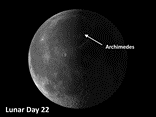The week of October 25-31 takes us from Day 20 to 25. This week we will highlight the moon crater Archimedes, viewable after midnight on Wednesday, Day 22.
 Archimedes1: [NW/G9; L=4°W] This is a prominent 50-mile crater with terraces and a surprisingly smooth floor. At sunrise Archimedes is a magnificent sight with shadow spires stretching across its internal plains. A similar image is reproduced on Plato’s smooth, dark chocolate floor [NW/D9] with even greater effect. Craters the size of Archimedes should have a hefty set of mountain peaks at their center. The peaks are actually there, but they have been completely covered by lava, now two miles deep, that flowed up through fractures in the floor. Because the lava had the viscosity of hot maple syrup, the floors appear nearly as smooth as an ice rink. As a result, there has been an informal competition over the years to see how many small impact craters can be made out on the floor. Make a quick drawing of the craterlets that you see, and come back later to try to improve on the count.
Archimedes1: [NW/G9; L=4°W] This is a prominent 50-mile crater with terraces and a surprisingly smooth floor. At sunrise Archimedes is a magnificent sight with shadow spires stretching across its internal plains. A similar image is reproduced on Plato’s smooth, dark chocolate floor [NW/D9] with even greater effect. Craters the size of Archimedes should have a hefty set of mountain peaks at their center. The peaks are actually there, but they have been completely covered by lava, now two miles deep, that flowed up through fractures in the floor. Because the lava had the viscosity of hot maple syrup, the floors appear nearly as smooth as an ice rink. As a result, there has been an informal competition over the years to see how many small impact craters can be made out on the floor. Make a quick drawing of the craterlets that you see, and come back later to try to improve on the count.
Compare Archimedes with its neighbors Aristillus and Autolycus [F10]. An examination of their rough floors will indicate that these two craters were formed after the Imbrium lava flows. Notice how the lavas have risen around Archimedes and partially bury its surrounding ejecta blanket.
Immediately south of Archimedes is a light-hued mountainous terrain. This feature is a curiosity in that it is the only part of the Imbrium basin that had not been inundated by lava flows. Charles Wood posits an interesting theory for this: He calls our attention to a large mass of material on the front side of the Apennines [G9-10] and to some long, narrow arcuate ridges on either side of this mass that poke up through the Imbrium lavas and hug the mountain range. He suggests that these formations are the tops of enormous terrace walls that slumped down onto the basin floor with such energy that this region was uplifted as a grand plateau and was protected from inundation by later lava flows.
1 Archimedes: (287 BCE – 212 BCE) Greek mathematician, inventor, and astronomer who most famously was given the problem of determining whether the king’s crown was truly made out of solid gold, but he was charged not to damage the crown in any way. He worked on the problem for quite a while, then as he was taking a bath one evening, he noticed that when he submerged his leg in the water, the water rose. He instantly realized that submerging the crown in water would displace an amount of water exactly equal to the volume of the crown, thus he could compare the volume to the density of gold. According to the story, he was so excited that he jumped out of the tub and ran naked down the street shouting, “Eureka, I have found it!” As it turned out, the goldsmith who had made the crown had duped the king and made off with some of the gold. (Common misconception: “Eureka, I have found it” does not mean, “Hooray, I have found it.” “Eureka” itself is Greek for “I have found it.”)
======================
It is highly recommended that you get a copy of Sky and Telescope’s Field Map of the Moon, the very finest Moon map available for use at the telescope. It is available for $10.95 at www.skyandtelescope.com and on Amazon. All features mentioned in this blog will be keyed to the grid on the Field Map and will look like this: Plato: [NW/D9]
Credits:
Courtesy of Gray Photography of Corpus Christi, Texas
Lunar photos: NASA / USGS / BMDO / LROC / ASU / DLR / LOLA / Moon Globe. Used by permission
- Rupes Cauchy: A Best Known Fault on the Moon - July 22, 2024
- Moon Crater Schickard – Crater Floor has Stripes - July 15, 2024
- Moon Craters Langrenus and Vandelinus - July 8, 2024